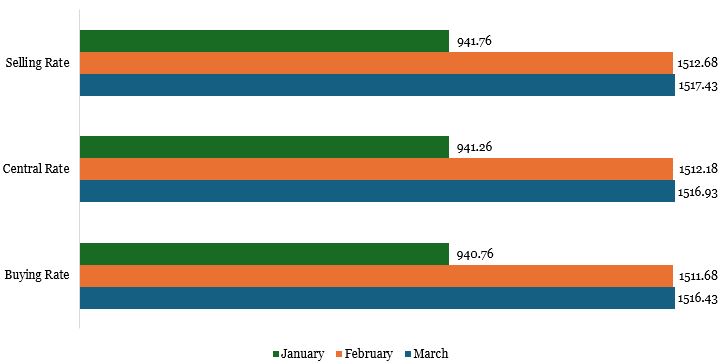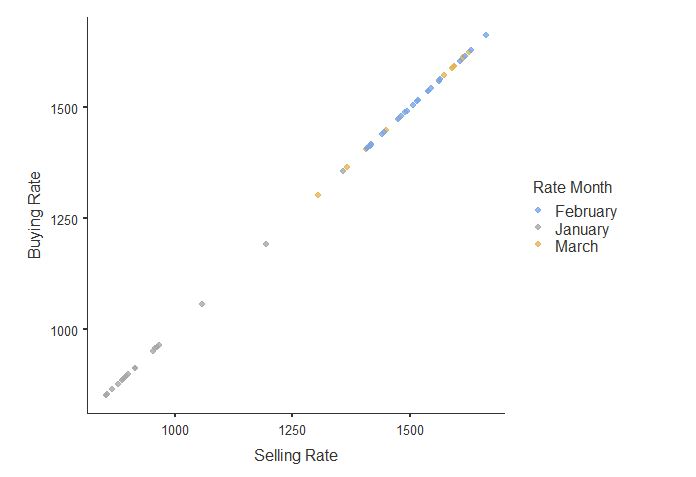
For the first time in three decades, Nigerians experienced what academics and public affairs specialists described as “severe panic” over the future of Africa’s most populous country. The fear escalated when the Naira’s floating policy against foreign currencies, particularly the US dollar, began to produce unforeseen results across sectors. The results began to have a significant impact on food and imported items in early February. As the data in Exhibits 1 and 2 show, Nigerians are clearly facing one of the most severe shocks of Naira depreciation.
The depreciation of the Naira has been a persistent concern for Nigerians and policymakers alike. Factors such as fluctuating oil prices, inadequate diversification of the economy, fiscal mismanagement, and external pressures have contributed to the erosion of the Naira’s value. Additionally, the prevalence of import dependency has exacerbated the situation, leading to a drain on foreign reserves and widening trade deficits.
As citizens grapple with the repercussions of a weakened currency, initiatives like the #BuyNaijaGrowNaija campaign spearheaded by Reno Omokri have emerged as beacons of hope, aiming to bolster the value of the Naira and revitalize the economy. In this thought leadership article, we delve into the dynamics of the Naira’s depreciation, the significance of the #BuyNaijaGrowNaija campaign, and propose strategies to ensure its success.
Register for Tekedia Mini-MBA edition 19 (Feb 9 – May 2, 2026): big discounts for early bird.
Tekedia AI in Business Masterclass opens registrations.
Join Tekedia Capital Syndicate and co-invest in great global startups.
Register for Tekedia AI Lab: From Technical Design to Deployment (next edition begins Jan 24 2026).
Exhibit 1: Average rate of Naira to Dollar (US) between January 1, and March 27, 2024

Exhibit 2: Linearity of selling and buying rate between January and March 2024

Reno Omokri believes that one of the important answers to the situation is for Nigerians to consume locally made goods and services from indigenous businesses. With this perspective, our analyst observes that Mr. Omokri has taken Nigerians back in time, calling their attention to the indigenous policies of governments in the early 1970s. According to Mr. Omokri, the goal is to encourage consumers to support indigenous firms, so driving economic growth, creating job opportunities, and ultimately strengthening the Naira.
Even though people are joining Mr. Omokri on X and other social media platforms by retweeting and creating content related to the campaign, our analyst observes that in order to ensure the campaign’s success, a number of strategies must be put into place. Regarding this, our analyst notes that in order to revive Nigerians’ interest in developing indigenous enterprises and the country’s economy in general, measures such as consumer education, government support, collaboration, awareness, and advocacy campaigns are needed now more than ever.
Initiatives must be developed to educate people about the benefits of purchasing locally produced goods. Highlighting the economic benefits, quality assurance, and good influence on communities might encourage people to make informed purchasing decisions. The government has an important role in promoting local industry growth. Policies such as tax breaks, access to financing, infrastructure development, and trade protection measures can help local firms prosper. The campaign’s successful implementation requires collaboration among government agencies, industry associations, financial institutions, and civil society organizations. By using the skills and resources of multiple stakeholders, synergies can be maximized, and difficulties handled collaboratively.
Embracing technology and innovation can help Nigerian products compete better in both domestic and international markets. Investments in R&D, digitization, and value chain optimization can increase efficiency and product quality. Continuous advocacy and awareness initiatives are required to maintain momentum and promote a cultural change toward supporting local industries. Leveraging traditional and digital media outlets, influencers, and community involvement efforts can help the campaign reach and affect more people.



